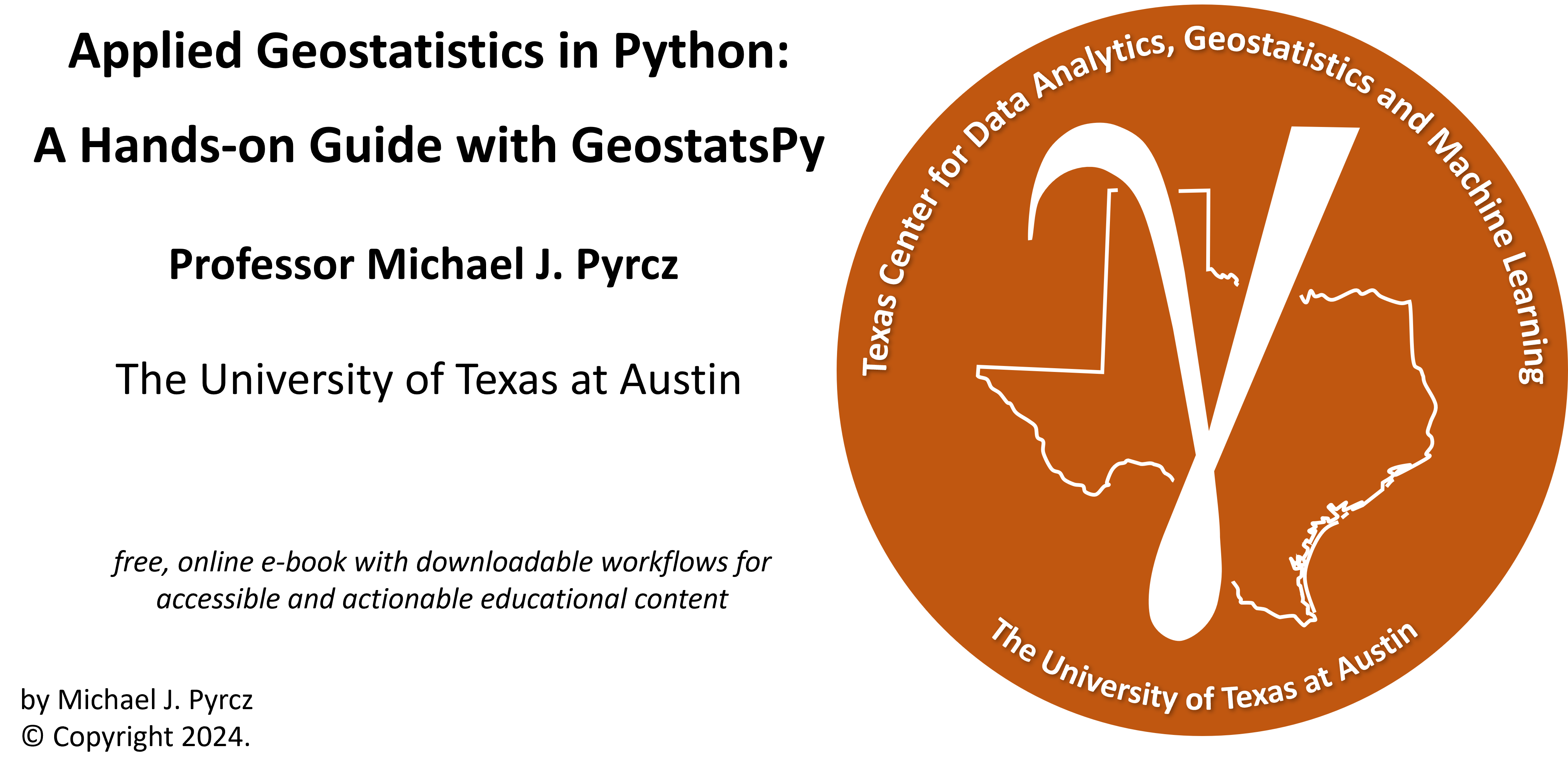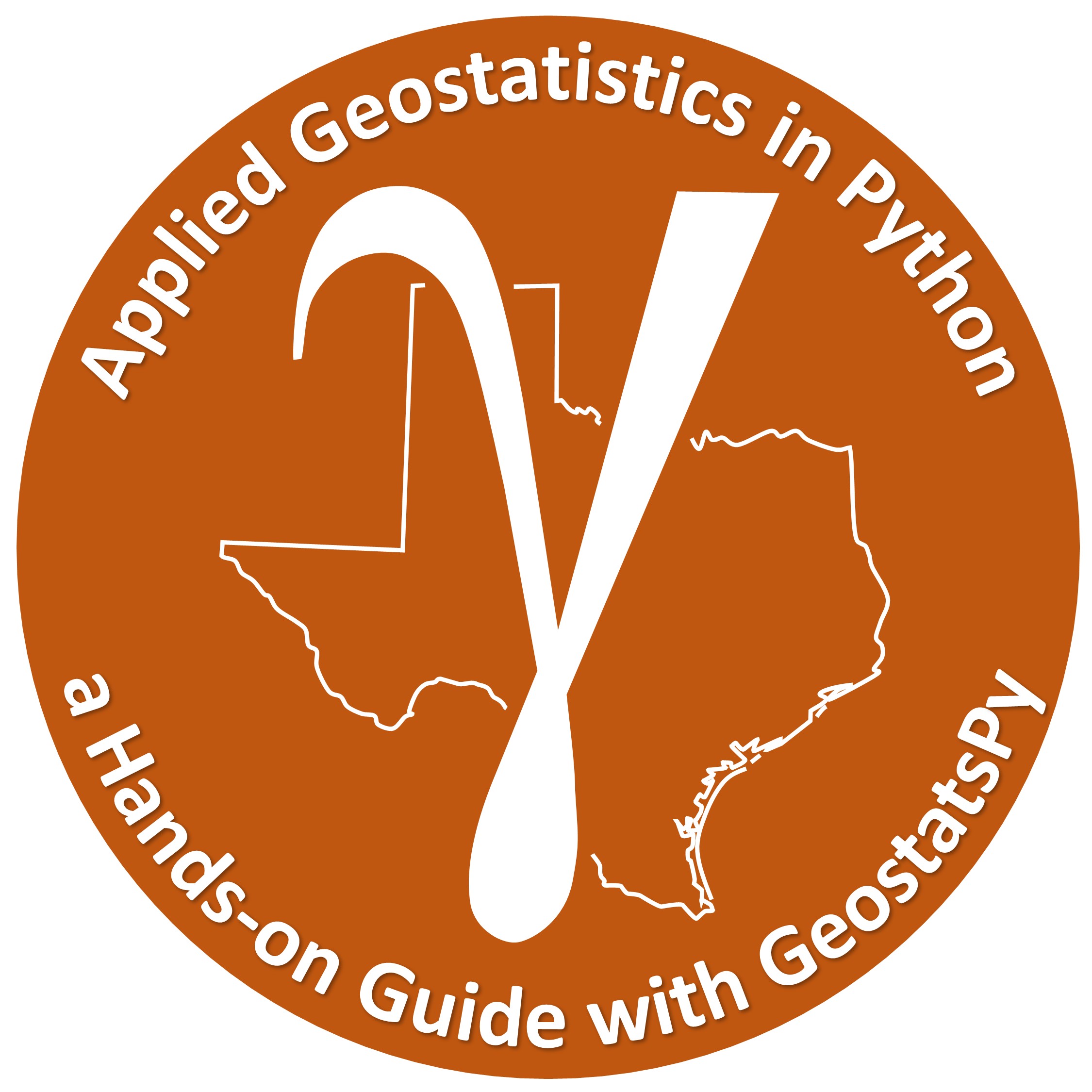
GeostatsPy Python Package#
Michael J. Pyrcz, Professor, The University of Texas at Austin
Twitter | GitHub | Website | GoogleScholar | Book | YouTube | Applied Geostats in Python e-book | LinkedIn
Chapter of e-book “Applied Geostatistics in Python: a Hands-on Guide with GeostatsPy”.
Cite this e-Book as:
Pyrcz, M.J., 2024, Applied Geostatistics in Python: a Hands-on Guide with GeostatsPy [e-book]. Zenodo. doi:10.5281/zenodo.15169133
The workflows in this book and more are available here:
Cite the GeostatsPyDemos GitHub Repository as:
Pyrcz, M.J., 2024, GeostatsPyDemos: GeostatsPy Python Package for Spatial Data Analytics and Geostatistics Demonstration Workflows Repository (0.0.1) [Software]. Zenodo. doi:10.5281/zenodo.12667036. GitHub Repository: GeostatsGuy/GeostatsPyDemos
By Michael J. Pyrcz
© Copyright 2024.
Installing GeostatsPy#
Firstly, if you haven’t installed GeostatsPy, here’s the GitHub repository GeostatsPy GitHub [PHK+21]. GeostatsPy is available on the Python Package Index (PyPI) GeostatsPy PyPI.
To install GeostatsPy, use pip
pip install geostatspy
GeostatsPy Package Dependencies#
The functions rely on the following packages:
numpy - for ndarrays
pandas - for DataFrames
numpy.linalg - for linear algebra
numba - for numerical speed up
scipy - for fast nearest neighbor search
matplotlib.pyplot - for plotting
tqdm - for progress bar
statsmodels - for weighted (debiased) statistics
These packages should be available with any modern Python distribution, e.g. Anaconda.
If you get a package import error, you may have to first install some of these packages. This can usually be accomplished by opening up a command window on Windows and then typing ‘python -m pip install [package-name]’. More assistance is available with the respective package docs.
About GeostatsPy#
The GeostatsPy Package brings GSLIB: Geostatistical Library[DJ97] functions and more geostatistics to Python. GSLIB is a practical and extremely robust set of code for building spatial modeling workflows.
I created the GeostatsPy Python Package to support my students in my courses:
I find my students benefit from hands-on opportunities, in fact it is hard to imagine teaching these topics without providing the opportunity to handle the numerical methods and build workflows. In 2017, I tried to have my students use the original FORTRAN executables, and even with support and worked out examples, it was an uphill battle. In addition, all my students and I are now working in Python for our research. Thus, having access to geostatistical methods in Python directly impacts and facilitates the research of my group. This package retains the spirit of GSLIB:
modularity - a collection of standalone functions that may be applied in sequence for maximum flexibility for building workflows
minimalist - the simplest possible code to support the “look at the code” approach to learning
fundamental - based on the well-established geostatistical theory by avoiding ad hoc methods and assumptions
The work on this Python package deepened my respect to the original geostatistics open-source authors, Prof. Clayton V. Deutsch and Prof. Andre G. Journel (emeritus).
This package contains 2 parts:
geostatspy.geostats includes GSLIB functions rewritten in Python. This currently includes all the variogram, distribution transformations, and spatial estimation and simulation methods. I will continue adding functions to support modeling operations for practical subsurface model construction.
geostatspy.GSLIB includes reimplementation of the GSLIB visualizations and low tech wrappers of the numerical methods (note: the low-tech wrapper require access to GSLIB executables as they write the parameter files, run the GSLIB .exe and read in the outputs).
Package Inventory#
Here’s a list and some details on each of the functions available.
geostatspy.GSLIB Functions#
Utilities to support moving between Python DataFrames and ndarrays, Data Tables, Gridded Data and Models in Geo-EAS file format (standard to GSLIB):
ndarray2GSLIB - utility to convert 1D or 2D numpy ndarray to a GSLIB Geo-EAS file for use with GSLIB methods
GSLIB2ndarray - utility to convert GSLIB Geo-EAS files to a 1D or 2D numpy ndarray for use with Python methods
Dataframe2GSLIB(data_file,df) - utility to convert pandas DataFrame to a GSLIB Geo-EAS file for use with GSLIB methods
GSLIB2Dataframe - utility to convert GSLIB Geo-EAS files to a pandas DataFrame for use with Python methods
DataFrame2ndarray - take spatial data from a DataFrame and make a sparse 2D ndarray (NaN where no data in cell)
Visualization functions with the same parameterization as GSLIB using matplotlib:
pixelplt - reimplementation in Python of GSLIB pixelplt with matplotlib methods
pixelplt_st - reimplementation in Python of GSLIB pixelplt with matplotlib methods with support for sub plots
pixelplt_log_st - reimplementation in Python of GSLIB pixelplt with matplotlib methods with support for sub plots and log color bar
locpix - pixel plot and location map, reimplementation in Python of a GSLIB MOD with MatPlotLib methods
locpix_st - pixel plot and location map, reimplementation in Python of a GSLIB MOD with MatPlotLib methods with support for sub plots
locpix_log_st - pixel plot and location map, reimplementation in Python of a GSLIB MOD with MatPlotLib methods with support for sub plots and log color bar
hist - histograms reimplemented in Python of GSLIB hist with MatPlotLib methods
hist_st - histograms reimplemented in Python of GSLIB hist with MatPlotLib methods with support for sub plots
Data transformations
affine - affine distribution transformation to correct feature mean and standard deviation
nscore - normal score transform, wrapper for nscore from GSLIB (GSLIB’s nscore.exe must be in working directory)
declus - cell-based declustering, 2D wrapper for declus from GSLIB (GSLIB’s declus.exe must be in working directory)
Spatial Continuity
make_variogram - make a dictionary of variogram parameters to for application with spatial estimation and simulation
gamv - irregularly sampled variogram, 2D wrapper for gam from GSLIB (.exe must be in working directory)
varmap - regular spaced data, 2D wrapper for varmap from GSLIB (.exe must be in working directory)
varmapv - irregular spaced data, 2D wrapper for varmap from GSLIB (.exe must be in working directory)
vmodel - variogram model, 2D wrapper for vmodel from GSLIB (.exe must be in working directory)
Spatial Modeling
kb2d - kriging estimation, 2D wrapper for kb2d from GSLIB (GSLIB’s kb2d.exe must be in working directory)
sgsim_uncond - sequential Gaussian simulation, 2D unconditional wrapper for sgsim from GSLIB (GSLIB’s sgsim.exe must be in working directory)
sgsim - sequential Gaussian simulation, 2D and 3D wrapper for sgsim from GSLIB (GSLIB’s sgsim.exe must be in working directory)
cosgsim_uncond - sequential Gaussian simulation, 2D unconditional wrapper for sgsim from GSLIB (GSLIB’s sgsim.exe must be in working directory)
Spatial Model Resampling
sample - sample 2D model with provided X and Y and append to DataFrame
gkern - make a Gaussian kernel for convolution, moving window averaging (from Teddy Hartano, Stack Overflow)
regular_sample - extract regular spaced samples from a 2D spatial model
random_sample - extract random samples from a 2D spatial model
DataFrame2ndarray - convent spatial point data in a DataFrame to a sparse ndarray grid
geostatspy.geostats Functions#
Numerical methods in GSLIB (Deutsch and Journel, 1997)[DJ97] translated to Python:
correct_trend - correct the order relations of an indicator-based trend model
backtr - GSLIB’s backtr function to transform a distribution
declus - GSLIB’s DECLUS program reimplemented for cell-based declustering in 2D
gam - GSLIB’s GAM program reimplemented for variogram calculation with regular data in 2D
gamv - GSLIB’s GAMV program reimplemented for variogram calculation with iregular data in 2D
varmapv - GSLIB’s VARMAP program reimplemented for irregularly spaced spatial data in 2D
vmodel - GSLIB’s VMODEL program reimplemented for visualization of nested variogram models in 2D
nscore - GSLIB’s NSCORE program reimplemented for normal score distribution transformation
kb2d - GSLIB’s KB2D program reimplemented for 2D kriging-based spatial estimation
ik2d - GSLIB’s IK3D program reimplemented for 2D indicator-based kriging estimation
kb3d - GSLIB’s kt3d program reimplemented for 3D kriging-based spatial kriging estimation
sgsim - GSLIB’s sgsim program reimplemented for 2D spatial simulation
postsim - GSLIB’s postsim program reimplemented for summarizing over multiple realizations
Want to Work Together?#
I hope this content is helpful to those that want to learn more about subsurface, spatial modeling, data analytics and geostatistics. Students and working professionals are welcome to participate. I’m happy to collaborate with your organization.
Want to invite me to visit your company for training, mentoring, project review, workflow design and / or consulting? I’d be happy to drop by and work with you!
Interested in partnering, supporting my graduate student research or my Subsurface Data Analytics and Machine Learning consortium (co-PIs including Profs. Foster, Torres-Verdin and van Oort)? My research combines data analytics, stochastic modeling and machine learning theory with practice to develop novel methods and workflows to add value. We are solving challenging subsurface problems!
I can be reached at mpyrcz@austin.utexas.edu.
I’m always happy to discuss,
Michael
Michael Pyrcz, Ph.D., P.Eng. Professor, Cockrell School of Engineering and The Jackson School of Geosciences, The University of Texas at Austin
More Resources Available at: Twitter | GitHub | Website | GoogleScholar | Book | YouTube | LinkedIn
